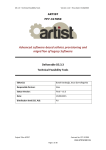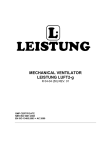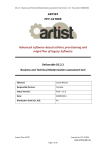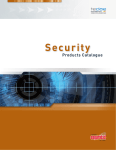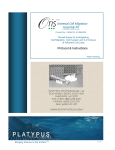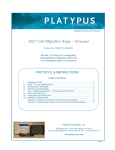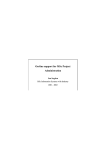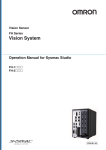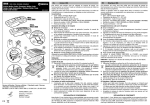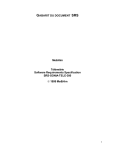Download D5.3.2 Technical Feasibility Tools_M24_30092014
Transcript
D5.3.2 – Technical Feasibility Tools
Version: v1.0 – Final, Date: 15/09/2012
ARTIST
FP7-317859
Advanced software-based seRvice provisioning and
migraTIon of legacy Software
Deliverable D5.3.2
Technical Feasibility Tools
Editor(s):
Burak Karaboğa, Jesus Gorroñogoitia
Responsible Partner:
Atos
Status-Version:
Final – v1.0
Date:
15/09/2014
Distribution level (CO, PU):
PU
Project Title: ARTIST
Contract No. FP7-317859
www.artist-project.eu
Page 1 of 37
D5.3.2 – Technical Feasibility Tools
Version: v1.0 – Final, Date: 15/09/2012
Project Number:
FP7-317859
Project Title:
ARTIST
Title of Deliverable:
D5.3.2 Technical Feasibility Tools
Due Date of Delivery to the EC:
30/09/2014
Workpackage responsible for
WP5 – Modernization Assessment
the Deliverable:
Editor(s):
Atos - Burak Karaboğa, Jesus Gorroñogoitia
Contributor(s):
Atos – Burak Karaboğa, Jesus Gorroñogoitia
Tecnalia – Zurik Corera, Juncal Alonso
Reviewer(s):
TUWien – Manuel Wimmer
Approved by:
All Partners
Recommended/mandatory
readers:
WP6, WP7, WP8, WP9, WP11
Abstract:
These tools analyse the complexity and coupling of
the source code of the legacy product, its data
schema and database technologies, and create
high level abstract models out of the legacy source
code that address the concerns related to its
migration into the desired target cloud platform,
providing an estimation of the work (effort) that
would be needed to transform the legacy product
into that target platform.
Keyword List:
Technical feasibility, Complexity, Maintainability
Licensing information:
TFT is delivered under EPL license.
The document itself is delivered as a description
for the European Commission about the released
software, so it is not public.
Project Title: ARTIST
Contract No. FP7-317859
www.artist-project.eu
Page 2 of 37
D5.3.2 – Technical Feasibility Tools
Version: v1.0 – Final, Date: 15/09/2012
Document Description
Document Revision History
Modifications Introduced
Version
Date
Modification Reason
Modified by
v0.1
01/09/14
First contributions for M24 release
ATOS
v0.2
04/09/14
Initial contributions to SCC section
TECNALIA
v0.3
10/09/14
Final contributions to SCC section
TECNALIA
V0.4
12/09/14
Final contributions and updates
ATOS
V1.0
15/09/2014
Final reviewed version
ATOS
Project Title: ARTIST
Contract No. FP7-317859
www.artist-project.eu
Page 3 of 37
D5.3.2 – Technical Feasibility Tools
Version: v1.0 – Final, Date: 15/09/2012
Table of Contents
Table of Contents .......................................................................................................................... 4
Table of Figures ............................................................................................................................. 5
Terms and abbreviations............................................................................................................... 6
Executive Summary ....................................................................................................................... 7
1
2
Introduction .......................................................................................................................... 9
1.1
About this deliverable ................................................................................................... 9
1.2
Document structure ...................................................................................................... 9
TFT ....................................................................................................................................... 11
2.1
Implementation........................................................................................................... 11
2.1.1
2.1.1.1
2.1.2
2.2
3
Functional Description ........................................................................................ 11
Fitting into overall ARTIST solution ................................................................. 11
Technical description .......................................................................................... 12
2.1.2.1
Prototype architecture .................................................................................... 12
2.1.2.2
TFT-UI .............................................................................................................. 14
2.1.2.3
Components description ................................................................................. 15
2.1.2.4
Technical Specifications .................................................................................. 15
Delivery and usage ...................................................................................................... 17
2.2.1
Package information ........................................................................................... 17
2.2.2
Installation instructions ....................................................................................... 19
2.2.3
User manual ........................................................................................................ 19
2.2.3.1
Inventory view ................................................................................................. 20
2.2.3.2
Migration strategy selection dialog................................................................. 22
2.2.3.3
Migration efforts view ..................................................................................... 23
2.2.3.4
Migration goals view ....................................................................................... 23
2.2.4
Licensing information .......................................................................................... 25
2.2.5
Download ............................................................................................................ 25
SCC....................................................................................................................................... 26
3.1
Implementation........................................................................................................... 26
3.1.1
Fitting into overall ARTIST solution ..................................................................... 26
3.1.2
Technical description .......................................................................................... 27
3.2
3.1.2.1
Prototype Architecture ................................................................................... 27
3.1.2.2
Components description ................................................................................. 28
3.1.2.3
Technical specifications ................................................................................... 28
Delivery and usage ...................................................................................................... 29
3.2.1
Package information ........................................................................................... 29
Project Title: ARTIST
Contract No. FP7-317859
www.artist-project.eu
Page 4 of 37
D5.3.2 – Technical Feasibility Tools
3.2.2
3.2.2.1
Version: v1.0 – Final, Date: 15/09/2012
Installation instructions ....................................................................................... 30
Requirements .................................................................................................. 30
3.2.3
User manual ........................................................................................................ 30
3.2.4
Licensing information .......................................................................................... 31
3.2.5
Download ............................................................................................................ 31
4
Interaction of TFT components ........................................................................................... 32
5
Conclusions ......................................................................................................................... 33
6
References ........................................................................................................................... 34
7
Appendix: TFT knowledge base (library of rules) ................................................................ 35
7.1
Migration Strategy Taxonomy ..................................................................................... 35
7.2
Migration strategies .................................................................................................... 37
Table of Figures
FIGURE 1 - ARTIST MIGRATION FEASIBILITY ASSESSMENT PACKAGE ........................................................ 12
FIGURE 2 - TFT ARCHITECTURE .......................................................................................................... 13
FIGURE 3 - PACKAGE STRUCTURE OF TFT ............................................................................................. 17
FIGURE 4 - ECLIPSE WORKBENCH WITH TFT VIEWS ................................................................................ 20
FIGURE 5 - OPENING A MODEL IN INVENTORY VIEW .............................................................................. 21
FIGURE 6 - SOURCE PATH SELECTIONS DIALOG ...................................................................................... 21
FIGURE 7 - INVENTORY VIEW ............................................................................................................. 22
FIGURE 8 - MIGRATION STRATEGY SELECTION DIALOG ........................................................................... 23
FIGURE 9 - MIGRATION EFFORTS VIEW ............................................................................................... 23
FIGURE 10 - OPENING THE MIGRATION GOALS VIEW .............................................................................. 24
FIGURE 11 - MIGRATION GOALS VIEW ................................................................................................ 24
FIGURE 12 - SCC IN OVERALL MATURITY ASSESSMENT PROCESS .............................................................. 27
FIGURE 13 - SCC HIGH LEVEL ARCHITECTURE ........................................................................................ 28
FIGURE 14 - PACKAGE STRUCTURE OF THE ARTIST METRICS PLUGIN ........................................................ 29
FIGURE 15 - SCC PROJECT ................................................................................................................. 30
FIGURE 16 - TESTING PACKAGE .......................................................................................................... 30
FIGURE 17 - SCC TESTING ................................................................................................................. 31
FIGURE 18 - INTERACTION OF TFT COMPONENTS .................................................................................. 32
Project Title: ARTIST
Contract No. FP7-317859
www.artist-project.eu
Page 5 of 37
D5.3.2 – Technical Feasibility Tools
Version: v1.0 – Final, Date: 15/09/2012
Terms and abbreviations
EC
European Commission
TFT
Technical Feasibility Tool
MAT
Maturity Assessment Tool
EMF
Eclipse Modelling Framework
UML
Unified Modelling Language
JAXB
Java Architecture for XML Binding
URL
Uniform Resource Locator
MPT
Methodology Process Tool
MUT
Model Understanding Tool
Project Title: ARTIST
Contract No. FP7-317859
www.artist-project.eu
Page 6 of 37
D5.3.2 – Technical Feasibility Tools
Version: v1.0 – Final, Date: 15/09/2012
Executive Summary
This document describes the Technical Feasibility Tool (TFT), which studies the feasibility of the
legacy application’s migration to cloud within the context of ARTIST pre-migration approach,
along with detailing the Software Complexity Component (SCC) which plays a major role in this
feasibility analysis.
The main motivation behind TFT is to assist the user to have a better understanding of the
migration to cloud process and the efforts required to accomplish this process in the ARTIST
pre-migration phase.
The purpose of this deliverable is to describe the modifications and new features developed
and released in the second version of the Technical Feasibility Tool detailing its design and
implementation and thus give an idea about the tool’s usability, capabilities and potential.
M24 version of the Technical Feasibility Tool introduces substantial amount of improvements
and changes to the existing UI elements and backend components. Besides these updates, the
tool’s functionalities and capabilities are also extended with new visual elements and backend
components.
Regarding the visual improvements; Migration Efforts View has been implemented to show the
user estimated efforts for each component and migration strategy which also contributed to
Inventory View to be more user friendly by reducing the information shown on it. Inventory
View has been improved with support for nested components, report creation and a new
dialog which assists the user on changing the assigned migration strategies on components.
Finally Migration Goals View has been updated to reflect the selection changes of target
platform immediately on the inventory view with updated migration strategy suggestions.
Regarding the implementation improvements; TFT and SCC has been integrated in order to
make use of the metrics information collected by SCC in effort estimation computations for
migration strategies and model components, suggestion updates upon user modification of
migration suggestions improved, migration strategy taxonomy has been defined and
incorporated into Drools, migration strategies (xml file) is restructured to support multiple
target platforms per strategy and serialized to be easily shareable with MPT in the context of
WP6, component models improved to include dependency relationship among components
and support for nested component structure and finally the rule knowledge base has been
extended to host more than 100 new rules supporting migration strategies for target platforms
GAE, AWS and Azure. In this second year the SCC has been enhanced with the calculation of
metrics analysing the relationship among classes (such as aggregation or generalization) as
well as the calculation of metrics at component level. As a result, the current prototype
provides an initial approximation of the maintainability metric (some metrics are still missing
and will be calculated for the last version of the prototype). The support to the C# solution has
also been improved for this version. The current prototype supports the calculation of the
metrics also for C# code, at the same level as it does for Java based code.
The document presents the missions, scopes, functional descriptions, technical approaches,
download & installation instructions and user manuals of these components comprising the
current version of the Technical Feasibility tools at M24. The deliverable focuses on
improvements and extensions upon the initial version of TFT provided on M12 and it refers to
deliverable D5.3.1 for unchanged features and details of the tool.
Project Title: ARTIST
Contract No. FP7-317859
www.artist-project.eu
Page 7 of 37
D5.3.2 – Technical Feasibility Tools
Version: v1.0 – Final, Date: 15/09/2012
The next iteration of this deliverable is planned to be at M30 with increased capabilities and
stability, a better integration and communication between TFT components and external
dependencies of TFT (e.g. other ARTIST tools). The next version is planned to extend the
existing knowledge base with new rules to handle more complex scenarios, make smarter
migration strategy suggestions, estimate efforts needed for migrations more precisely, be
more user friendly and responsive.
Project Title: ARTIST
Contract No. FP7-317859
www.artist-project.eu
Page 8 of 37
D5.3.2 – Technical Feasibility Tools
Version: v1.0 – Final, Date: 15/09/2012
1 Introduction
1.1 About this deliverable
The purpose of Technical Feasibility Tools (TFT) is to offer an early technical analysis of the
migration of an existing non-Cloud compliant application, by conducting an analysis of the
Maturity Assessment Tool's (MAT) report, and the high level component models of the
application extracted by the Model Understanding Toolbox, in order to obtain a set of
component maintainability metrics, migration strategy suggestions and migration effort
estimations, which altogether offers a migration feasibility technical report. In the context of
ARTIST, TFT assists the user in the pre-migration phase by displaying the analysis results and
suggesting migration strategies to the users about their existing systems in a responsive way.
TFT is comprised of different components which have different roles in the analysis process of
the migration candidate legacy application. These components are; component detector,
strategy suggestor, software complexity component, effort estimator and TFT repository, last
of which is not offered in this version. Component detector is responsible for analyzing the
high level component model obtained from MUT and population of the component data
model in the memory. Strategy suggestor examines this data model and migration goals
obtained from MAT in order to suggest appropriate migration strategies for each component.
Software complexity component (SCC) is responsible for the analysis of the source code, class
model and the component model to calculate the complexity metrics for the whole application
and each individual high level component. The effort estimator uses the complexity values
detected by SCC and the migration strategies suggested by strategy suggestor to estimate the
effort needed to migrate each component and also the whole application to the target
platform.
This deliverable describes the technical and functional aspects, the role in the overall ARTIST
solution, installation details and user manuals of TFT components in detail while also focusing
on the new features and changes that has been implemented on them for the M24 Prototype
release.
1.2 Document structure
This document is divided into three main sections describing TFT in general, detailing the SCC
component of TFT and lastly presenting the interaction between TFT components. The
document is concluded followed by the References and the Appendix.
This version of the deliverable focuses on the updates and new features with respect to the
previous release, therefore the unchanged sections/subsections will refer to the old version.
The first two sections are divided into subsections; Implementation and Delivery and Usage.
Implementation sections focus on functional and technical aspects of the components in
several subsections of their own. These subsections include information about functional
aspects, fitting into overall ARTIST solution and technical aspects such as prototype
architecture, components description and technical specifications. Delivery and Usage section
focuses on what is delivered, how to download, install and use this deliverable. The package
information subsection describes the package contents; the classes, resources and library files
used by the component. Download and Installation Instructions sections explain how to
download the prototype from the repository, how to install it as well as the prerequisites in
detail. The User Manual section describes the Eclipse Views and other elements that the user
can interact with that are offered by each component of TFT.
Project Title: ARTIST
Contract No. FP7-317859
www.artist-project.eu
Page 9 of 37
D5.3.2 – Technical Feasibility Tools
Version: v1.0 – Final, Date: 15/09/2012
Interaction of TFT Components section focuses on the communication between TFT IDE and
SCC components, describing the API offered by SCC and how TFT uses this API to calculate
effort estimations for suggested migration strategies.
The Appendix section describes the taxonomy of migration tasks and lists the remarkable
migration strategies offered by TFT in two subsections.
Project Title: ARTIST
Contract No. FP7-317859
www.artist-project.eu
Page 10 of 37
D5.3.2 – Technical Feasibility Tools
Version: v1.0 – Final, Date: 15/09/2012
2 TFT
2.1 Implementation
2.1.1 Functional Description
The Technical Feasibility Tool (TFT), whose technical description is provided in [1], aims at
supporting ARTIST users on the early technical assessment of the migration of a legacy
application to the cloud. At this early stage (e.g. pre-migration phase in ARTIST Methodology),
the ARTIST users need to be supported to evaluate the feasibility of the migration, attending
its technical aspects, since even for a very simple legacy application, its migration to the cloud
could be a complex process, that may require non negligible efforts and concrete expertise to
be accomplished. Moreover, the support for decision making at this early pre-migration stage
requires a detailed breakdown of the migration process into a set of technical tasks, not only
to estimate their required efforts, but also to identify other resources needed to accomplish
every task, including the selection of the appropriate technical expertise or even the detection
of dependencies among tasks or other technical intricacies.
In this context, the role of this version of TFT prototype is to offer technical information about
the legacy application itself, suggest technical strategies to migrate its components to the
cloud and to offer migration effort estimations for each component marked for migration by
analyzing the information in the migration goals of the MAT report, the high level view of the
application provided by Model Understanding Tool (MUT), SCC’s metric analysis as well as user
preferences [3] and lastly generation of the TFT report for the consumption of Methodology
Process Tool (MPT).
The prototype is responsive to user interactions such as, modifications on MUT’s output,
elimination of migration goals from MAT’s report and re-assignment of migration strategy
suggestions on components. These interactions trigger the analysis process of TFT and thus
updating the migration strategy suggestions, complexity and effort estimations.
TFT may be considered as a high-level technical analysis for the whole legacy application. What
MUT provides to TFT is a filtered, refined model of the legacy system and this output requires
a certain analysis of structure to be created as well but this reveals what the system “is”. TFT,
on the other hand, aims to find out what the application “can” be or “should” be. This is why
TFT’s analysis is considered to be high-level.
2.1.1.1 Fitting into overall ARTIST solution
Next picture depicts the main TFT components and their dependencies and/or relationships
with other ARTIST components. Note that not all TFT foreseen dependencies and interactions,
as described in next figure, are implemented in M24 prototype. As commented in this section,
current version of TFT integrates MAT reports and MUT high level models. For further details
see [5] D5.3.1 Technical Feasibility Tools and [6] D6.4.1 ARTIST Integrated Architecture.
Project Title: ARTIST
Contract No. FP7-317859
www.artist-project.eu
Page 11 of 37
D5.3.2 – Technical Feasibility Tools
Version: v1.0 – Final, Date: 15/09/2012
Figure 1 - ARTIST Migration Feasibility Assessment Package
2.1.2 Technical description
2.1.2.1 Prototype architecture
Next figure outlines TFT tool architecture design. M24 implementation implements
new versions of the components, Software Complexity Component (SCC), TFT UI
and also new versions of Effort Estimator and Strategy Suggestor. TFT supports
partial integration with MAT reports and MUT high level models. Despite this report
describes the complete TFT architecture for the M24 prototype.
Project Title: ARTIST
Contract No. FP7-317859
www.artist-project.eu
Page 12 of 37
D5.3.2 – Technical Feasibility Tools
Version: v1.0 – Final, Date: 15/09/2012
Figure 2 - TFT Architecture
TFT consists of a set of Eclipse elements (views, widgets, wizards), a set of backend
components and a set of external dependencies; all of which are described below
TFT tool consists of:
a set of Eclipse views and other widgets and wizards, which constitute the TFT UI and
contributes to the Eclipse workbench through its exposed extension points. In this
version (M24) of the prototype, Migration Efforts View has been introduced to this set
of views. Among the other existing views, Inventory View and Migration Goals View
have been improved in this version.
a set of backend components, which provides some important TFT services, such as:
o Component Detector
o Software Complexity Component
o Effort Estimator
o Strategy Suggestor
o TFT Repository (a bunch of TFT required artefacts stored in the ARTIST
Repository)
Component Detecor, Software Complexity Component and Effort Estimator have been
improved significantly, the details of these improvements can be found in section
2.1.2.3. As a new back-end component, Strategy Suggestor has been improved in this
version, the details of which can also be found in section 2.1.2.3.
a set of external dependencies, notably other ARTIST components and tools, accessed
through well-defined interfaces:
o Maturity Assessment Tool (MAT)
o Business Feasibility Tool (BFT)
o Target Specification Tool (TST)
o Model Understanding Tool (MUT)
o M’M Transformation Tool (M2MTT)
o Reusability Analysis Tool (RAT)
Project Title: ARTIST
Contract No. FP7-317859
www.artist-project.eu
Page 13 of 37
D5.3.2 – Technical Feasibility Tools
o
o
Version: v1.0 – Final, Date: 15/09/2012
ARTIST Repository
Methodology Framework Tool (MFT)
There has been no significant updates on the interaction between TFT and these
external dependencies except a better analysis is now carried out for MUT’s
output and a future work is planned for M30 to use MAT’s new report in GML
(Goal Modeling Language) format.
Next sections describe in more details TFT plugin components and dependencies.
2.1.2.2 TFT-UI
TFT offers its functionality through TFT UI, which the user can use to interact with TFT and its
backend components. TFT UI contributes to the Eclipse workbench, complementing the Eclipse
ARTIST perspective. The following views have been improved or newly developed in this M24
TFT UI release (see [D5.3.1] for detailed description of TFT UI views included in M12 TFT
release):
Inventory of components View: M24 version of this view has been updated with lots
of changes and improvements upon existing functionality. The view now supports the
display of nested components and multiple migration strategy suggestions per
component. The migration strategy suggestion modifications are now done via a
dialog where the user can see all the compatible and suggested strategies instead of a
combo box. A report creation function and an option to open the new Migration
Efforts View have also been added to the view.
Migration Efforts View: This newly introduced view can be reached through the
Inventory view, which displays detailed information about the component complexity,
overall migration complexity and overall migration effort for each component.
o Component complexity: The complexity of the component obtained from the
SCC.
o Overall migration complexity: This is the information of how complex would it
be to perform all the suggested migration strategies for this component
during the migration process.
o Overall migration effort: The estimated effort for this component to be
migrated to the target platform.
The view also contains complexity and effort information for the migration of the all
application. The user can also get detailed information on one component by double
clicking the component’s row. This user action brings front a dialog where complexity
of the component, complexity values for each assigned strategy and effort
estimations for each individual strategy is displayed.
Migration Goals View: This version of the prototype’s migration goals view is now fully
responsive to user actions. Although the view does not allow the modification of the
migration goals, the user is now able to select which migration goal should be taken
into consideration for migration thus affecting the migration strategy suggestion
process. This selection is done via checking or unchecking the checkboxes associated
for each migration goal in the migration goals view. The goals can be mass-selected or
deselected by clicking the checkbox of a parent node. The user can also modify the
target platform selection through this view which is now reflected on the migration
strategy suggestions, complexity and effort calculations. This modification on the
target platform selection is done by using the target platform combo box provided in
this view. The user is free to select any target platform that is supported by TFT from
the list of platforms in the combo box.
Project Title: ARTIST
Contract No. FP7-317859
www.artist-project.eu
Page 14 of 37
D5.3.2 – Technical Feasibility Tools
Version: v1.0 – Final, Date: 15/09/2012
See [5] D5.3.1 - Technical Feasibility Tools for other views which belong to TFT-UI.
2.1.2.3 Components description
The following TFT backend components provide business logic support to the TFT UI:
Component Detector: In this version of the prototype, this component has been improved to
take inter-component and parent child relationships between high level components into
account for a better understanding of the migration candidate application.
Software Complexity Component: This component has been updated with several changes
and improvements in this version of the prototype including new metrics calculation and
supporting other technologies other than Java (C#). These updates are detailed in section 3 of
the document.
Strategy Suggestor: This new component is responsible for analysing the components of the
non-cloud compatible application and the relationships between these components and
suggesting certain migration strategies for each component to assist the user in the premigration process. As the Component Detector, this component also relies on the high level
component models generated by MUT in order to have a basis for the analysis of the
application. Strategy Suggestor is also responsive to user feedback and dynamically analyses
the model to update strategy suggestions.
Effort Estimator: This new component estimates the effort required to accomplish each
required migration strategy suggested for each component that are marked for migration. This
estimation is based on:
The task type and complexity, which is calculated based on heuristics and the user
range estimation (low, average, high)
The complexity of affected component, which is estimated by the SCC.
The number of reusability components for each task as well as the reusability level.
Weighted factors obtained from heuristics
In this current version of the TFT prototype, Effort estimator is responsible for assigning effort
weight values to each suggested migration strategy according to strategy complexity. These
values are then used to calculate the estimated effort values for each component once SCC the
metrics from SCC are obtained (See section 4).
TFT Repository: This component is not offered in this version of the prototype but planned to
be available with the next deliverable in M30. This component will store historical data and
heuristics required to estimate efforts. The M24 TFT implementation is local, that is, this
content is shipped within TFT plugin upon installation from ARTIST update site. Incoming
version will rely on the ARTIST repository to store and retrieve this information.
2.1.2.4 Technical Specifications
TFT, as an Eclipse plugin, is based on Eclipse RCP libraries and written in Java. TFT requires Java
6, a minimum Eclipse version of 4.3 (Kepler), and plugins EMF-Ecore, EMF-Query, Papyrus,
UML2 installed.
User Interface
M24 version of TFT does not introduce a change in technology used within the user interface
except a minor addition which introduces the usage of Eclipse dialogs for migration strategy
selections in Inventory View and display of detailed information about complexity and effort
Project Title: ARTIST
Contract No. FP7-317859
www.artist-project.eu
Page 15 of 37
D5.3.2 – Technical Feasibility Tools
Version: v1.0 – Final, Date: 15/09/2012
values in the Migration Efforts View. For functional changes and improvements on TFT UI, see
section 2.1.2.2.
For technical specifications of TFT UI, see [5] D5.3.1 Technical Feasibility Tools
Back-End
Although there is no introduction of new technologies in this version (M24), the back-end of
TFT has been significantly improved with regards to M12 version of the prototype. For the
technologies used in the back-end of TFT see [5] D5.3.1 Technical Feasibility Tools
Software complexity component is now fully integrated to the other components to TFT
enabling a more precise calculation of effort estimations for each component and migration
strategy. In M12 version, Migration strategy definitions were hard coded into TFT the
knowledge base. These definitions are moved to a an XML file which is parsed on TFT launch to
populate a migration strategy container to be used by TFT components to ensure a more
maintainable and modular implementation. The component model has also been extended to
include dependency relationships among components and support nested component
structure.
The knowledge base of TFT has been enhanced with more than 100 new rule addition handling
complex suggestion scenarios and providing migration strategy suggestion support for target
platforms; AWS, Windows Azure and Google App Engine. The knowledge base has also been
improved to handle the update of migration strategy suggestions upon user modifications on
existing suggestions.
An example to a migration strategy suggestion scenario from M24 version of TFT would be:
rule "IsStandardComponent"
when
$component : Component ( !applicationLevelComponent )
then
//SUPER RULE - DO NOTHING
end
rule "IsDataTypeComponent" extends "IsStandardComponent"
when
eval ($component.hasStereotype(Category.DATA.getPossibleStereotypes()))
then
//SUPER RULE - DO NOTHING
End
rule "Data_NOSQL" extends "IsDataTypeComponent" agenda-group
"GAE"
when
eval(mGoals.getTechnicalGoals().getA_p().getDatabaseScalabilityRequirements().equals(
"NO-SQL"))
then
MigrationStrategy strategy =
MigrationStrategyContainer.INSTANCE.getMigrationStrategy("HRD");
strategy.setComplexity(Complexity.HIGH);
strategy.setSuggested(true);
$component.addMigrationStrategy(strategy);
end
rule "Data_RDBMS" extends "IsDataTypeComponent" agenda-group
"GAE"
when
eval(mGoals.getTechnicalGoals().getA_p().getDatabaseScalabilityRequirements() ==
"RDBMSmultitenant")
then
Project Title: ARTIST
Contract No. FP7-317859
www.artist-project.eu
Page 16 of 37
D5.3.2 – Technical Feasibility Tools
Version: v1.0 – Final, Date: 15/09/2012
MigrationStrategy strategy =
MigrationStrategyContainer.INSTANCE.getMigrationStrategy("CLOUD_SQL");
strategy.setComplexity(Complexity.LOW);
strategy.setSuggested(true);
$component.addMigrationStrategy(strategy);
end
For a given component which is not marked as an application level component, the first rule
IsStandardComponent returns true. Then a second rule IsDataTypeComponent which extends
the first one gets fired and if this component has one of the stereotypes in the DATA category
applied on it, the rule returns true. The second and third rules extend the
IsDataTypeComponent rule so both of them get fired. The extending rules check the database
scalability requirement of the migration goals. If the requirement is equal to NO-SQL, then the
migration strategy is set to be HRD and complexity HIGH. If not and the requirement is set to
RDBMSmultitenant then the migration strategy is set to CLOUD_SQL and complexity to LOW.
The future work plan includes enhancing and improving these rules even more to be more
comprehensive, making use of all the information we have on the legacy components in a
smart way to decide which migration strategy and which level of complexity should be
assigned to the component.
2.2 Delivery and usage
2.2.1 Package information
Delivery package consists of the below folder structure.
Figure 3 - Package structure of TFT
Project Title: ARTIST
Contract No. FP7-317859
www.artist-project.eu
Page 17 of 37
D5.3.2 – Technical Feasibility Tools
Version: v1.0 – Final, Date: 15/09/2012
src: See [5] D5.3.1 - Technical Feasibility Tools.
eu.artist.tft.actions: See [5] D5.3.1 - Technical Feasibility Tools.
commands: See [5] D5.3.1 - Technical Feasibility Tools.
dialog: Contains the MigrationStrategySelectionDialog.java which handles the dialog
operations for Migration Strategy selection for a specific component. The
EffortDetailsDialog.java implements the dialog where the effort and complexity details for a
component are shown to the user. ModelSourceSelectionDialog.java implements a dialog
where the user is asked to select the source code paths for the component model. This source
path information is used to estimate the migration effort fort each component.
edit: Contains the MigrationSuggestionEditingSupport.java which offers editing support for
the Migration Strategy cells in the Inventory View table.
effort: Contains the EffortCalculator.java and effort_weight.properties which contains
operations for effort calculations for Migration Strategies and effort weight values
respectively.
model: This package contains Java models of UML components, Migration Goals:
BusinessGoals.java, Component.java, MigrationGoals.java, TechnicalGoals.java and
MigrationGoalsContainer.java. The sub-package query contains ComponentModelQuery.java
class. This class has the necessary methods for querying the UML Component Diagrams. The
migration
strategy
sub-package
contains
Category.java,
Complexity.java,
MigrationStrategies.java,
MigrationStrategy.java,
MigrationStrategyContainer.java,
MigrationStrategies.xml, and MigrationStrategies.xsd. The classes in this sub-package are
java class mappings of the migration strategies which are defined in the
MigrationStrategies.xml.
rules: This package contains StrategySuggestion.drl, StrategySuggestionUpdate.drl and
GetAllAvailableStrategies.drl Drools files. The first file contains all the necessary rules for
the migration strategy suggestions in the Inventory view. The second file contains the rules
that filter out the strategy suggestion combo box data from unrelated data. The last rule file
contains the rules which fetch all compatible migration strategies for a specific component.
views: Contains the TFT views; InventoryView.java, MigrationGoalsView.java and
MigrationEffortsView.java
models: Contains the usecase UML models, migration goals report and petstore UML model
to be used for testing purposes.
profiles: Contains the UML profiles, which are applied to the models in the models folder.
lib: See [5] D5.3.1 - Technical Feasibility Tools.
META-INF: See [5] D5.3.1 - Technical Feasibility Tools.
plugin.xml: See [5] D5.3.1 - Technical Feasibility Tools.
Project Title: ARTIST
Contract No. FP7-317859
www.artist-project.eu
Page 18 of 37
D5.3.2 – Technical Feasibility Tools
Version: v1.0 – Final, Date: 15/09/2012
2.2.2 Installation instructions
TFT plugin will be available for installation using Eclipse’s Install New Software feature via
ARTIST’s update site in the future. Now, it can be downloaded and installed manually. Eclipse
4.2 (Juno) is required for installation but Eclipse 4.3 (Kepler) is recommended.
Installation Procedure of Required Plugins
EMF-Ecore, EMF-Query, Papyrus, UML2 plugins are required to be installed. All these plugins
may be installed by following the installation procedure below:
1. On the Help menu of Eclipse, click Install New Software.
2. From the “Work with” dropdown list select Kepler or Juno depending on your Eclipse
version. If you don’t have these entries in the list continue on from step 2a otherwise
continue from step 3.
a. Click Add button at the right side of the Work with dropdown list.
b. Write a name of your choice for the Kepler/Juno repo.
c. Write
http.download.eclipse.org/releases/kepler
or
http://download.eclipse.org/releases/juno to the Location field and click Ok.
3. Select the plugin(s) you want to install (EMF Core, EMF Query, UML2 and Papyrus
UML) click next and follow the instructions on screen.
4. Restart Eclipse.
TFT Installation Procedure
1. Download eu.artist.premigration.tft.tft.jar and eu.artist.premigration.tft.scc.jar files
from ARTIST repository.
2. Copy these jar files to Eclipse’s dropins folder.
3. Restart Eclipse
2.2.3 User manual
A general view of the Eclipse Workbench with TFT views and views that interact with TFT open
is below.
Project Title: ARTIST
Contract No. FP7-317859
www.artist-project.eu
Page 19 of 37
D5.3.2 – Technical Feasibility Tools
Version: v1.0 – Final, Date: 15/09/2012
Figure 4 - Eclipse workbench with TFT views
At the top pane, a sample test project containing a JEE6 Component model diagram of the
legacy application is open. By right clicking the Papyrus container, the DI or the UML file, the
Inventory view can be opened. Also, MG2.xml can be seen inside the testing project. This MAT
report file is used to open the Migration Goals View which can be seen on the upper right
region of Figure 4: Eclipse workbench with TFT-TFT views.
On the middle-left pane, a UML Editor is open. The user is free to modify the model on this or
another UML editor of her/his choice (e.g. Papyrus). The model with the new modifications is
analysed and suggestions are updated once the user saves the changed model. On the right of
this pane the Migration Goals View can be seen. On the bottom page, two tabs can be seen,
Inventory View and the Migration Efforts View. These three views will be explained in detail in
the following sections.
2.2.3.1 Inventory view
In order to open the Inventory View, the user must first open the Migration Goals View since
the migration tasks to be suggested in the Inventory View depends on the migration goals. If
the user tries to open the Inventory View before the Migration Goals View, a warning message
pops up, informing the user about this, and asks for Migration Goals View to be opened first.
To open the inventory view of TFT plugin, the user should right click the component diagram
UML file which is the output of model discovery process and select Show in Inventory View
menu action. This action can also be found in the context menus of the files of type .di and
Papyrus Model Containers.
Project Title: ARTIST
Contract No. FP7-317859
www.artist-project.eu
Page 20 of 37
D5.3.2 – Technical Feasibility Tools
Version: v1.0 – Final, Date: 15/09/2012
Figure 5 - Opening a model in Inventory View
After selecting the “Show in Inventory View” menu option, the user will see the dialog below
asking the source file location(s) of the selected component model.
Figure 6 - Source path selections dialog
Using this dialog’s “Add source path” button the user should locate the source folders
containing the classes referred by the component model then press OK to proceed and open
the inventory view.
Project Title: ARTIST
Contract No. FP7-317859
www.artist-project.eu
Page 21 of 37
D5.3.2 – Technical Feasibility Tools
Version: v1.0 – Final, Date: 15/09/2012
The inventory view consists of a table which has the components of the selected component
diagram. Component name, stereotypes, the classes owned by the component and the
migration strategies suggested for the component by TFT can be seen in each row.
Figure 7 - Inventory View
The user is given the option to change the suggested migration strategy for a specific
component. This is done by clicking the Migration Strategy Suggestion cell of the component in
the table and clicking the ... button on the right-side of the cell. This action opens the
Migration Strategy Selection Dialog which is described in detail in the next section.
Inventory view is fully responsive to the changes on the migration strategy selections and also
to the changes on the component model. If the user modifies migration strategy selections for
a component via the Migration Strategy Selection Dialog and clicks ok, the rule engine steps in
and refreshes the migration strategy suggestions for all components. This automatic
suggestion update can be disabled using the checkbox below the Inventory View table. Also, if
the user decides to add a component, or changes a component’s properties by using the
component editor, the inventory view is refreshed and the strategy suggestions are
recalculated when the changed model is saved.
2.2.3.2 Migration strategy selection dialog
The migration Strategy Selection Dialog opens when the user selects the migration strategy cell
for a component in the Inventory View and clicks the ... button. In this dialog, the user is free
to change the migration strategy suggested by TFT, remove strategies and add new ones. The
dialog allows only one strategy per category.
For example, if the component has both Data and Framework related features, two migration
strategies are suggested; Migrate to Google Cloud SQL and Migrate to Spring. In order to add
another Data related migration strategy, let’s say Migrate to HRD, the user first has to remove
the Migrate to Google Cloud SQL strategy from the Selected Migration Strategies list.
If the selected migration strategies are modified, the user is warned about the possibility of
the update on the migration strategy suggestions of the components that has a dependency
relationship with the component selected, after the Ok button is clicked.
Project Title: ARTIST
Contract No. FP7-317859
www.artist-project.eu
Page 22 of 37
D5.3.2 – Technical Feasibility Tools
Version: v1.0 – Final, Date: 15/09/2012
Figure 8 - Migration Strategy Selection Dialog
2.2.3.3 Migration efforts view
To open the Migration Efforts View the user should click on the Open Efforts View button
provided in the Inventory View. This view contains a table where for each component, the
component complexity, overall migration complexity and overall migration effort is shown
(Figure 8: Migration Efforts View). The user can double click or right click a component and
select show details menu option to bring forth a dialog where complexity information for each
migration strategy suggested for this component can be seen.
Figure 9 - Migration Efforts View
2.2.3.4 Migration goals view
To open the Migration Goals View of TFT plugin, the user should right click the xml file
containing the migration goals which is generated by the MAT and select Show in Migration
Goals View menu action.
Project Title: ARTIST
Contract No. FP7-317859
www.artist-project.eu
Page 23 of 37
D5.3.2 – Technical Feasibility Tools
Version: v1.0 – Final, Date: 15/09/2012
Figure 10 - Opening the migration goals view
The Migration Goals view consists of a combo box and a tree table.
The combo box is filled with supported target cloud platforms with regards to the MAT
report and default value is selected with respect to the value of the target platform in
the migration goals. The combo box value can be changed by the user, which surely
affects the suggested migration strategies in the Inventory View.
The tree table lists the migration goals in a parent – child relationship with their
respective values. The user has no control over these values but can enable and
disable the goals by clicking the checkboxes. In case the user wants to edit the values
of the migration goals, he/she has to start over the MAT questionnaire again and go
through the same process since these goals are determined by MAT based on the
user’s responses. Enabling/disabling the goals also affects the migration strategy
suggestions in the Inventory View.
Figure 11 - Migration Goals View
Project Title: ARTIST
Contract No. FP7-317859
www.artist-project.eu
Page 24 of 37
D5.3.2 – Technical Feasibility Tools
Version: v1.0 – Final, Date: 15/09/2012
2.2.4 Licensing information
This component is offered under EPL v1.0 license.
2.2.5 Download
Source code for this version of the TFT prototype may be viewed\downloaded from the ARTIST
Tooling Github repository, here.
Project Title: ARTIST
Contract No. FP7-317859
www.artist-project.eu
Page 25 of 37
D5.3.2 – Technical Feasibility Tools
Version: v1.0 – Final, Date: 15/09/2012
3 SCC
3.1 Implementation
The Software Complexity Component (SCC) aims to provide a new set of metrics in the
technical feasibility phase prior to the migration. Thus, the results from metrics analysis can
provide a better insight whether migration should be feasible or not.
In the first version of the prototype delivered in M12, the Level of Complexity (LOC) metric was
provided for each Java class.
In the current version of the prototype, at M24, a set of new metrics are provided. These
metrics allow the calculation of the Modifiability, Understability and Scalability (partially)
metrics [1], which in combination with the LOC metric (provided in the previous version of the
prototype), support the calculation of the final metric to be provided by the SCC, the
Maintainability metric.
Furthermore, in the current version of the SCC, metrics for C# based code are also supported.
So the input to the SCC can be source code from an application written in any of the two
technologies supported by the ARTIST project.
The metrics provided by the current version of the prototype are those needed to calculate the
Level of Complexity (already provided in the M12 prototype) the Modifiability, Understability
and partially the Scalability. The new atomic metrics calculated by the M24 prototype are:
NGen: Number of generalizations: The Number of Generalization metric is defined as
the total number of generalization relationships within a class diagram (each parentchild pair in a generalization relationship).
NAggH: Number of aggregation Hierarchies: The Number of Aggregation Hierarchies
metric is defined as the total number of aggregation hierarchies within a class diagram.
The Number of Aggregation metric is defined as the total number of aggregation
relationships within a class diagram (each whole-part pair in an aggregation
relationship).
MaxDIT: Maximum Depth of Inheritance. The Maximum DIT metric is defined as the
maximum between the DIT value obtained for each class of the class diagram. The DIT
value for a class within a generalization hierarchy is the length of the longest path from
the class to the root of the hierarchy.
These metrics are calculated per component (defined in the component model by the MUT).
3.1.1 Fitting into overall ARTIST solution
SCC prototype is part of the Technical Feasibility Tool. In the first version of the prototype, SCC
and TFT were provided as separate components, but in the current version of the prototype,
they are provided as a single tool.
TFT (and thus SCC) is the tool that ARTIST project provides to perform the Technical Feasibility
analysis proposed in pre-migration phase of the ARTIST methodology (see Figure 1).
Project Title: ARTIST
Contract No. FP7-317859
www.artist-project.eu
Page 26 of 37
D5.3.2 – Technical Feasibility Tools
Version: v1.0 – Final, Date: 15/09/2012
Figure 12 - SCC in overall Maturity Assessment process
SCC as part of the TFT is also part of the modernization assessment package (see section 2.1.1).
3.1.2 Technical description
3.1.2.1 Prototype Architecture
The current SCC prototype architecture is a Java API that explores source files an UML
models to generate several metrics of a specific project. The following image depicts the
overall architecture:
Project Title: ARTIST
Contract No. FP7-317859
www.artist-project.eu
Page 27 of 37
D5.3.2 – Technical Feasibility Tools
Version: v1.0 – Final, Date: 15/09/2012
Figure 13 - SCC high level architecture
While the main objective of the Artist Metrics Generator is to expose an API that any other
plug-in or RCP could use to obtain the metrics generated in the Artist project, it also provides
Test Cases to access the same functionality as if used programmatically. The generated metrics
are available in XML files and console log.
3.1.2.2 Components description
The current SCC prototype component comprises three components:
Metric Explorer: This is the main component of SCC current prototype. It provides the
calculation of all the required metrics that are used to generate the new ARTIST
metrics. Besides, it also provides exporting features to convenient formats like XML or
JSON.
Structures: This component contains the structures of the inputs and outputs models
that the Metric Explorer uses. It also provides the functionality for generating the
output file formats (XML, JSON).
Test Cases: This component is provided for implementing the testing of the Metric
Explorer component. It generates several use cases that test the functionality of the
SCC. The test case generates console logs and XML files with several examples (DEWS
and JavaPetStore).
3.1.2.3 Technical specifications
All the components are developed in JavaSE 1.6. So this is the minimum java version for
executing the API. There are no any other requirements.
Project Title: ARTIST
Contract No. FP7-317859
www.artist-project.eu
Page 28 of 37
D5.3.2 – Technical Feasibility Tools
Version: v1.0 – Final, Date: 15/09/2012
User Interface
There is no user interface implemented as the result obtained from SCC is to be consumed by
TFT-TFT and used for the required effort calculation (see section 4). For executing the Metrics
Explorer API the user has to execute the test cases included in the API. Several input
parameters can be changed for obtaining new metrics of different projects.
Back-end
There is no persistency implemented neither planned for this API. Thus, every time the new
metrics are needed, they have to be calculated. Persistency is delegated to API consumers.
3.2 Delivery and usage
3.2.1 Package information
The following image depicts the package structure of the main component, the Artist metrics
generator plug-in.
Figure 14 - Package structure of the ARTIST metrics plugin
Project Title: ARTIST
Contract No. FP7-317859
www.artist-project.eu
Page 29 of 37
D5.3.2 – Technical Feasibility Tools
Version: v1.0 – Final, Date: 15/09/2012
eu.artist.premigration.tft.scc.metricexplorer: Contains the classes for exploring the
UML models and the source code.
eu.artist.premigration.tft.scc.strucctures: Contains the classes of the structures used
by the metric explorer component
eu.artist.premigration.tft.scc.test: Contains the test cases classes for executing the
metric explorer component.
umlmodels: This folder contains the UML models used in the test cases and other UML
models also.
3.2.2 Installation instructions
In this version of the prototype this plug-in requires manual installation. The user has to import
the components to the Eclipse workspace manually.
3.2.2.1 Requirements
All the components are developed in JavaSE 1.6. So this is the minimum Java version for
executing the API.
3.2.3 User manual
Import the project into the Eclipse workspace:
Figure 15 - SCC project
Open the eu.artist.premigration.tft.scc.test package
Figure 16 - Testing package
Right click in a test case and select the Run as Java Application option:
Project Title: ARTIST
Contract No. FP7-317859
www.artist-project.eu
Page 30 of 37
D5.3.2 – Technical Feasibility Tools
Version: v1.0 – Final, Date: 15/09/2012
Figure 17 - SCC testing
Note: The user has to change the ”hardcoded” input parameters of the test cases manually
3.2.4 Licensing information
This component is offered under EPL license.
3.2.5 Download
This second release of SCC is available in the ARTIST github, more precisely at the following
address:
https://github.com/artist-project/ARTIST-Tooling/pre-migration/technicalfeasibilitytool/SCC
Project Title: ARTIST
Contract No. FP7-317859
www.artist-project.eu
Page 31 of 37
D5.3.2 – Technical Feasibility Tools
Version: v1.0 – Final, Date: 15/09/2012
4 Interaction of TFT components
The two components of TFT interact with each other in order to present the user an effort
estimation of the selected migration strategies for each component. Figure 4 depicts an overall
picture of this interaction.
Figure 18 - Interaction of TFT components
SCC offers the MetricCalculator class containing the getMetricsByComponent method to be
used by TFT to obtain the metrics calculated by SCC. The method signature can be found
below.
getMetricsByComponent(HashMap<String, List<String>> classFiles, List<String>
srcPaths, String ComponentModelPath, String ClassModelPath, int type)
This method requires a map which has the component name as the key and the class files
contained by this component as the value, a list of source paths which the source files can be
found in, the path of the component model, the path of the class model and the source type
(i.e.
java,
c#
etc.).
The
method
returns
a
list
of
components
(eu.artist.premigration.tft.scc.structures.Component), each containing the metric
information of the TFT components that are included in the component model of the
migration candidate (eu.artist.premigration.tft.tft.model.Component).
TFT uses the metric information and the migration strategy complexities to calculate the
estimated effort for each component’s migration towards cloud. The calculated effort
estimation is displayed in the Migration Efforts View which can be accessed from the Inventory
View.
Project Title: ARTIST
Contract No. FP7-317859
www.artist-project.eu
Page 32 of 37
D5.3.2 – Technical Feasibility Tools
Version: v1.0 – Final, Date: 15/09/2012
5 Conclusions
This document described the functionality, architecture, delivery method and
installation/usage details of Technical Feasibility Tools, detailed the SCC component and the
interaction between TFT components. The second version of TFT prototype containing several
new features has also been provided.
In this version of the deliverable, SCC component introduced the Maintainability, Modifiability
Metrics and the first design of the API that TFT will use to obtain the metrics from SCC. A
baseline for the migration task effort estimation computation which will make use of the
aforementioned metrics SCC will provide has been implemented. This information is shown on
the Migration Efforts View along with component complexity and the migration strategies’
complexities in a range of Low, Average and High. The combo boxes that allowed the user to
select migration strategies has been switched with an Eclipse dialog which enables multiple
strategy selections in a more user friendly way. Automatic migration strategy updates have
been introduced which updates the migration strategies suggested for components which
have a dependency relationship with the ones user has modified their migration strategy. The
knowledge base of TFT has also been enlarged with new rules and new migration strategies
derived from work package 9 [4].
In the next iteration, the focus will be on enhancing the knowledge base of rules supporting
more complex scenarios and more specialized migration strategies, completing the
implementation of the interaction between TFT’s components and adding a support for MAT’s
new report format in GML.
Project Title: ARTIST
Contract No. FP7-317859
www.artist-project.eu
Page 33 of 37
D5.3.2 – Technical Feasibility Tools
Version: v1.0 – Final, Date: 15/09/2012
6 References
[1] D5.1.1 – Specification of the Business and Technical Modernization Assessment in
ARTIST
[2] D6.2.1 – ARTIST – Methodology
[3] D8.3 – ARTIST - D8.3 Methodology and techniques for model understanding M18
[4] WD9.4 – ARTIST – WD9.4 Collection of Optimization Patterns
[5] D5.3.1 - Technical Feasibility Tools
[6] D6.4.1 - ARTIST Integrated Architecture
Project Title: ARTIST
Contract No. FP7-317859
www.artist-project.eu
Page 34 of 37
D5.3.2 – Technical Feasibility Tools
Version: v1.0 – Final, Date: 15/09/2012
7 Appendix: TFT knowledge base (library of rules)
7.1 Migration Strategy Taxonomy
In order to migrate a system to the cloud, certain tasks have to be fulfilled. These tasks may
require modifications on the system itself and definitely some work has to be done on the
target platform as well. These tasks can be organized within 4 main categories, Installation &
Configuration, Modification, Migration and finally, Testing, which consist of more precise, subcategories.
Installation and Configuration
Software installation and/or configuration may be needed locally or on cloud, for IaaS
migrations, depending on the candidate system for migration before starting the code
modification. The installations and configurations may be required or may just be a case of
“nice to have”.
An example for a requirement would be the case where a Java application, which uses JPA, is
to be migrated to the cloud with SimpleDB. In this situation a third party library, SimpleJPA has
to be installed and configured.
Although packaging and deployment of the application are in the context of the Migration
category, some installation and/or configuration might be needed to automate/ease some
parts of the migration process. For example: Azure plugin for Visual Studio must be installed in
order to benefit from its automated packaging feature.
Modification
Modification category focuses on the required modifications on the system before migration
and consists of 3 sub-categories: Database Changes, Code Changes and Connection Changes.
The scope of modification depends on many parameters; target platform, the modules that
are planned to be migrated or not, compatibility of the local and the target platforms etc.
Database changes: If the database is also planned to be migrated to the cloud, it is
very likely that some modification will be needed. Database scripts and schema
modifications might be necessary in following situations:
Difference of database versions
Difference of database variants (MySQL vs MSSQL)
Difference of database types (Relational vs NoSQL)
Code changes: If migration goals include enhancing overall performance, switching to
more contemporary technologies etc., changes on the written code would be
inevitable. Also if there has been a modification on the database, code change would
probably be needed.
Database access layers, models may need to be rewritten. An example would
be JPA to SimpleJPA conversion.
In a case of an MVC application migration, CDI Managed beans and controllers
might be modified to integrate with Spring.
Project Title: ARTIST
Contract No. FP7-317859
www.artist-project.eu
Page 35 of 37
D5.3.2 – Technical Feasibility Tools
Version: v1.0 – Final, Date: 15/09/2012
Connection changes: Typically, two components of a system are connected with a LAN
connection before the migration. According to the migration strategy, this connection
may change to a WAN connection or a LAN connection in cloud. For either case,
modifications below might be necessary,
Protocol optimizations to ensure data transfer efficiency
Security optimizations. If there will be a switch from LAN to WAN, some
additional threat scenarios should be considered.
Migration
Being the last step before testing, this category defines the process of configuration and
preparation of the modules targeted for migration and should be trivial if the previous steps
are handled properly.
Configuration: Application configuration files should be change\modified to handle
the modifications done on the code in the previous category and also according to the
target platform requirements.
Additionally, some configurations on the project nature might be necessary in order to
make use of some third party plugins. For example, Azure plugin for Visual Studio
automates package and configuration file creation process, but in order to use the
plugin, the project to be migrated must be a “Web Application Project”. If it is a “Web
Site Project”, it has to be converted to a Web Application Project first.
Preparation: In order to deploy the application and/or the database to the cloud some
certain preparations may be required.
Preparation of the database: If the scripts had not been changed in the code
modification step, some configuration changes might be necessary in order to
use third party tools for DB migration automation.
Preparation of the application: Before the deployment, the application has to
be packaged. In case of migrating to PaaS application may be required to be
packaged according to a certain format.
Testing
This one of the most important - if not the most important - part of the migration as a whole. A
successful deployment to cloud (migration process) is a proof of some of the actions taken are
not erroneous; configuration changes, installations on IaaS etc. but this does not ensure that
the application would run as expected.
Testing process should be well planned and carried out carefully. One example procedure for
testing might be as follows:
Testing if database migration to cloud is successful.
Testing the application in local servers can communicate with the DB in Cloud.
Testing if the migration of the application to cloud is successful
Testing if the application in cloud can communicate with the DB in cloud.
Project Title: ARTIST
Contract No. FP7-317859
www.artist-project.eu
Page 36 of 37
D5.3.2 – Technical Feasibility Tools
Version: v1.0 – Final, Date: 15/09/2012
Carrying out functional, performance, security etc. tests
7.2 Migration strategies
Adopt Cloud Watch: This migration strategy suggests to adopt the Cloud Watch Service
offered by Amazon EC2. Amazon CloudWatch is a monitoring service offered by Amazon that
controls all the time the use of cloud infrastructure resources and allows system
administrators to establish scaling rules based on the values of certain metrics.
Migrate to App Engine Datastore: This strategy suggests that necessary changes should be
made on the component so that it becomes compatible with Google App Engine’s Datastore.
This service provides a schema-less object datastore including a query engine, atomic
transactions support via the Datastore API. Its primary data repository (High Replication
Datastore) replicates its stored data in multiple data centers providing high read/write
availability and durability. Datastore is scalable in terms of reads and writes. Writes scale by
distributing write data when necessary while reads scale by only permitting queries whose
performance depends solely on the result set. Query serving uses pre-built indexes which
impose restrictions on the supported operations over the stored data.
Migrate to Task Queue API: This strategy suggests that the related component should adopt
and use the Google App Engine’s Task Queue API (TQA). TQA allows applications to perform
work outside of a user request, initiated by a user request. The work is divided into separate
tasks and these task are pushed to task queues in order to be processed in aggregate.
Adopt Amazon Direct Connect: This migration strategy suggests adopting Amazon Direct
Connect. This service offered by Amazon, enables the establishment of a dedicated network
connection between AWS and other resources. It serves for keeping constant network latency
needed in case of real-time data feeds as well as for utilize Amazon's infrastructure together
with other infrastructure controlled by the user.
Test Database Connections: This migration strategy suggests testing the database connections
after migration. Testing of the connection between the local servers and the DB in the cloud
and the connection between the application in the cloud and the DB in the cloud should be
carried out.
Project Title: ARTIST
Contract No. FP7-317859
www.artist-project.eu
Page 37 of 37





































